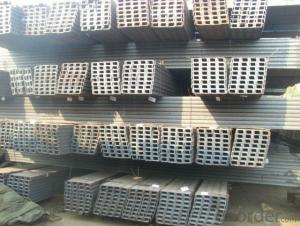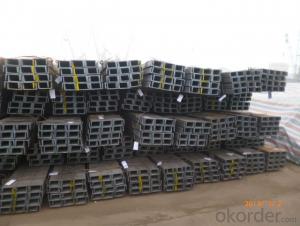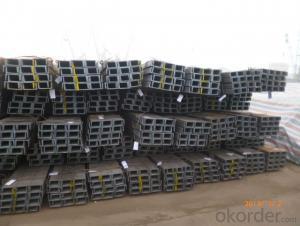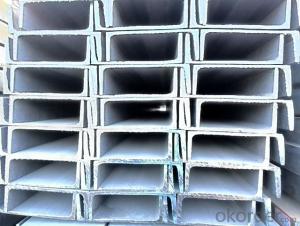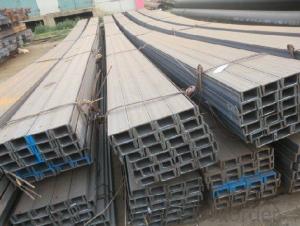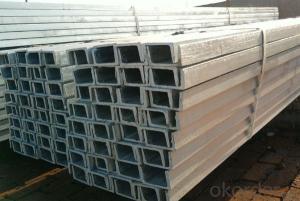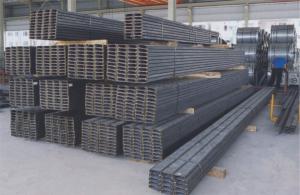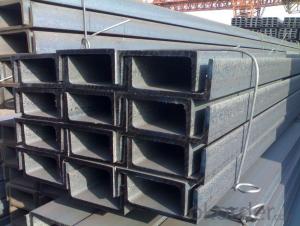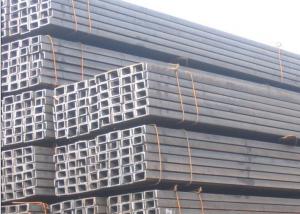JIS U-Channels with Lowest Price Hot Rolled
- Loading Port:
- Tianjin
- Payment Terms:
- TT OR LC
- Min Order Qty:
- 25 m.t
- Supply Capability:
- 10000 m.t/month
OKorder Service Pledge
OKorder Financial Service
You Might Also Like
Specification
Okorder.com is a professional materials & equipment supplier & manufacturer, offers integrated one-stop services including real-time quoting and online cargo tracking. We are funded by CNBM Group, a Fortune 500 enterprise and the largest materials & equipment firm in China.
Product Applications:
The MS Channel can be applied to construction of warehouses, workshops, sport stadiums and car parks etc.The hot rolled channel steel belongs to carbon structural steel which is applied to in the field of construction and machinery.In details, the hot rolled channel steel is usually used for arch-itechtural structure, and they could be welded in order to support or hang a vari-ety of facilities. They are also usually used in combination with I beam. Generally,the hot rolled channel steel we supply must possess perfect welding property, riveting property and mechanical property and so on.
Product Advantages:
OKorder's Steel U-Channels are durable, strong, and resist corrosion.
Main Product Features:
· Premium quality
· Prompt delivery & seaworthy packing (30 days after receiving deposit)
· Corrosion resistance
· Can be recycled and reused
· Mill test certification
· Professional Service
· Competitive pricing
Product Specifications:
1.We supply high quality MS Channel at reasonable price, including Chinese standard, Japanese standard and so on.
Standard | GB/JIS |
Material Grade | Q235,SS400 |
Technique: | Hot Rolled |
Sizes as per chinese standard: | 50*37*4.5mm - 300*89*11.5mm |
Sizes as per japanese standard: | 50*25*3mm – 200*80*7.5mm |
Length: | 6meter, 9meter, 12meter |
Note: 1.we are also competent to provide our customers other MS Channel based on other sizes according to customer’s requirements.
2. The length of our ms channel could be cut into other meters as per customer’s requirements. For example, the channel in 6meters could be cut into 5.8meters in order to be fit in the 20ft container.
2. The detailed sections of MS Channel as per GB standard.are shown in the table-1:
GB U CHANNEL | Standard | Sectional | Dimension |
| Mass: |
| (mm) | (mm) | (mm) | (mm) |
|
50X37 | 50 | 37 | 4.50 | 7.0 | 5.438 |
63X40 | 63 | 40 | 4.80 | 7.5 | 6.634 |
80x43 | 80 | 43 | 5.00 | 8.0 | 8.045 |
|
|
|
|
|
|
100x48 | 100 | 48 | 5.30 | 8.5 | 10.007 |
120x53 | 120 | 53 | 5.50 | 9.0 | 12.059 |
140x58 | 140 | 58 | 6.00 | 9.5 | 14.535 |
140x60 | 140 | 60 | 8.00 | 9.5 | 16.733 |
|
|
|
|
|
|
160x63 | 160 | 63 | 6.50 | 10.0 | 17.240 |
160x65 | 160 | 65 | 8.50 | 10.0 | 19.752 |
|
|
|
|
|
|
180x68 | 180 | 68 | 7.00 | 10.5 | 20.174 |
180x70 | 180 | 70 | 9.00 | 10.5 | 23.000 |
|
|
|
|
|
|
200x73 | 200 | 73 | 7.00 | 11.0 | 22.637 |
200x75 | 200 | 75 | 9.00 | 11.0 | 25.777 |
|
|
|
|
|
|
220x77 | 220 | 77 | 7.00 | 11.5 | 24.999 |
220x79 | 220 | 79 | 9.00 | 11.5 | 28.453 |
|
|
|
|
|
|
250x78 | 250 | 78 | 7.00 | 12.0 | 27.410 |
250x80 | 250 | 80 | 9.00 | 12.0 | 31.335 |
250x82 | 250 | 82 | 11.00 | 12.0 | 35.260 |
|
|
|
|
| |
280x82 | 280 | 82 | 7.50 | 12.5 | 31.427 |
280x84 | 280 | 84 | 9.50 | 12.5 | 35.823 |
280x86 | 280 | 86 | 11.50 | 12.5 | 40.219 |
|
|
|
|
|
|
300x85 | 300 | 85 | 7.50 | 13.5 | 34.463 |
300x87 | 300 | 87 | 9.50 | 13.5 | 39.173 |
300x89 | 300 | 89 | 11.50 | 13.5 | 43.883 |
Table-1
3. The chemical composition of HR Channel Steel according to Q235B is shown in Table-2.
Alloy No | Grade | Element(%) | ||||
C | Mn | S | P | Si | ||
Q235 | B | 0.12-0.20 | 0.3-0.7 | ≦0.045 | ≦0.045 | ≦0.3 |
Table-2
Note: we are able to present our customers relevant SGS test report for chemical composition of HR Channel Steel.
4. The mechanical property of HR Channel Steel according to Q235B is shown in Table-3-1 and Table-3-2
Alloy No | Grade | Yielding Strength Point(Mpa) | |||
Thickness(mm) | |||||
≦16 | >16-40 | >40-60 | >60-100 | ||
≧ | |||||
Q235 | B | 235 | 225 | 215 | 205 |
Table-3-1
Alloy No | Grade | Tensile Strength(Mpa) | Elongation After Fracture(%) | |||
Thickness(mm) | ||||||
≦16 | >16-40 | >40-60 | >60-100 | |||
≧ | ||||||
G235 | B | 375-500 | 26 | 25 | 24 | 23 |
Table-3-2
Note: we are able to present our customers relevant SGS test report for mechanical property of MS Channel as customer’s request.
FAQ:
Q1: Why buy Materials & Equipment from OKorder.com?
A1: All products are carefully selected from China's most reliable manufacturing enterprises. Through its ISO certifications, OKorder.com adheres to the highest standards and a commitment to supply chain safety and customer satisfaction. We can guarantee the quality!
Q2: The products are invoicing on theoretical weight or on actual weight?
A2: We can do it in both manners, it’s according to buyer's requirement.
Q3: Can fit in the containers of 20fts for 6M long ?
A3: Yes, we can put them into the containers in the form sideling, in this way we can save the buyer much ocean freight.
Images:
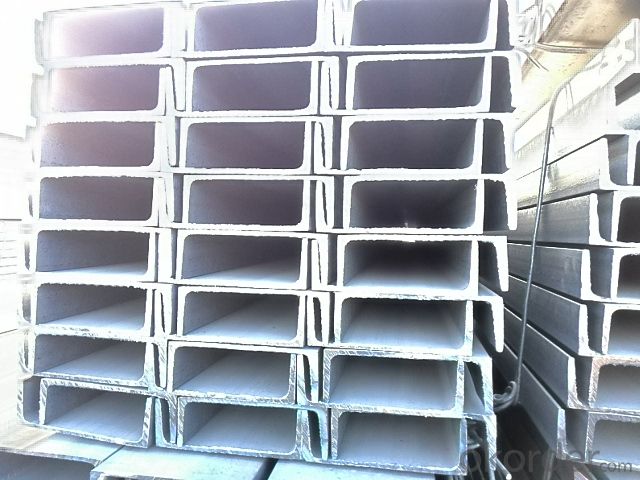
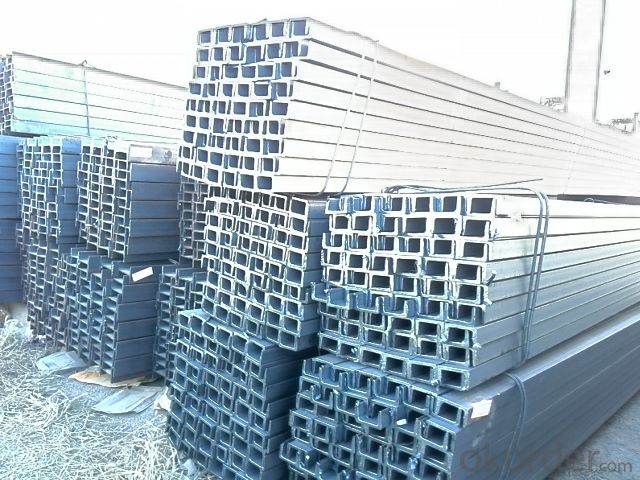
- Q: Can steel channels be used for creating staircases or handrails?
- Yes, steel channels can be used for creating staircases or handrails. Steel channels are versatile and strong, making them an ideal choice for constructing staircases and handrails. They provide structural support and stability, ensuring the safety of individuals using the stairs or handrails. Steel channels can be easily fabricated and customized to fit specific design requirements, making them suitable for various architectural styles. Additionally, steel channels are durable and resistant to wear and tear, making them a long-lasting option for staircases and handrails.
- Q: Are steel channels suitable for use in agricultural applications?
- Yes, steel channels are suitable for use in agricultural applications. They are highly durable, strong, and resistant to environmental factors such as weather and pests. Steel channels can be used for various purposes in agriculture, including constructing animal enclosures, framing structures, and supporting equipment. Their versatility and reliability make them a popular choice in the agricultural industry.
- Q: What are the different surface protection techniques for steel channels?
- To prevent corrosion and enhance the durability of steel channels, there are several surface protection techniques available. These techniques are as follows: 1. Galvanization: Applying a protective zinc coating to the steel channel serves as a sacrificial anode, creating a barrier against corrosion. Galvanized steel channels are highly resistant to rust and can withstand harsh environmental conditions. 2. Powder coating: The application of a dry powder to the steel channel, followed by heating, creates a durable and protective finish. This technique provides excellent resistance against corrosion, chemicals, and UV rays, while also offering a wide range of color options. 3. Epoxy coating: Epoxy coatings are suitable for steel channels exposed to chemicals or harsh environments. By applying a layer of epoxy resin, a protective barrier forms against corrosion, abrasion, and impact. 4. Paint coatings: Painting the steel channel with a layer of paint is a cost-effective surface protection method. The paint acts as a barrier, preventing moisture and oxygen from reaching the metal surface, thus reducing the risk of corrosion. Depending on specific requirements, different types of paints, such as acrylic, enamel, or epoxy, can be used. 5. Stainless steel cladding: This method involves covering the steel channel with a layer of stainless steel. Stainless steel is highly resistant to rust and oxidation, providing excellent corrosion resistance. Additionally, it offers a visually appealing and durable finish. 6. Hot-dip coating: Immersing the steel channel in a bath of molten zinc creates a thick and uniform zinc coating. This technique provides exceptional protection against corrosion and is commonly used in outdoor applications where the steel channel may be exposed to moisture, chemicals, or extreme temperatures. Each of these surface protection techniques has its own advantages and suitability for specific applications. The choice of technique depends on factors such as the environment, desired aesthetics, durability requirements, and budget considerations.
- Q: Can steel channels be used in signage applications?
- Yes, steel channels can be used in signage applications. They provide durability, stability, and a sleek appearance, making them suitable for outdoor and indoor signage installations. Additionally, steel channels can be easily customized and fabricated to meet specific design requirements, making them a versatile choice for signage applications.
- Q: What are the different types of clamps used for steel channels?
- There are several different types of clamps that are commonly used for steel channels, each serving a specific purpose. These clamps are designed to securely fasten and support steel channels, ensuring stability and structural integrity in various applications. 1. Beam clamps: Beam clamps are specifically designed to attach steel channels to beams or other structural members. They typically feature a screw or bolt mechanism that allows for easy installation and adjustment, providing a secure attachment point. 2. U-bolt clamps: U-bolt clamps are shaped like a U and are used to secure steel channels to pipes, rods, or other cylindrical objects. They provide a strong and reliable connection, often used in applications where there is a need to attach channels to round or curved surfaces. 3. Pipe clamps: Pipe clamps are commonly used to support steel channels that are attached to pipes. They typically have a split design that allows for easy installation around the pipe, with screws or bolts to secure the clamp to the channel. 4. Rigid clamps: Rigid clamps are heavy-duty clamps designed for applications where maximum strength and stability are required. They provide a rigid connection between steel channels and other structural components, ensuring minimal movement or flexing. 5. Channel clamps: Channel clamps are specifically designed to connect two steel channels together. They often feature a sliding mechanism that allows for easy adjustment and alignment, ensuring a secure and precise connection. In addition to these specific types of clamps, there may be variations or specialized clamps available for specific applications or requirements. It is important to choose the appropriate clamp based on the specific needs of the steel channel installation to ensure proper support and durability.
- Q: What factors should be considered when selecting steel channels?
- To ensure the appropriate choice for the intended application, it is necessary to take several factors into account when selecting steel channels. Firstly, the material grade of the steel channels should be considered. Different grades of steel offer varying levels of strength, durability, and corrosion resistance. The specific requirements of the application, such as load-bearing capacity and exposure to environmental conditions, will determine the suitable material grade. The size and dimensions of the steel channels must align with the project's requirements. This encompasses the height, width, and thickness of the channel, which will determine its load-bearing capacity and structural stability. The shape and design of the steel channels should be chosen based on the specific application and structural requirements. There are various options available, including C-channels, U-channels, and miscellaneous channels. C-channels are commonly used for structural support, while U-channels are often employed for framing and edging purposes. The manufacturing standards and certifications of the steel channels should be carefully considered. Opt for channels that comply with recognized industry standards to ensure their quality, consistency, and suitability for the intended application. The surface finish of the steel channels can impact their appearance, corrosion resistance, and ease of maintenance. Choose between options such as hot-dip galvanized, powder coated, or mill-finished channels. The choice should be based on the project's aesthetic requirements and the level of protection needed against corrosion. Cost-effectiveness is an important factor to evaluate. Compare the prices of different steel channels against their performance, quality, and longevity. Choosing the cheapest option may compromise the long-term performance and durability of the channels. Lastly, consider the reputation and reliability of the supplier. Ensure they have a track record of delivering high-quality steel channels and providing excellent customer support. This includes factors such as on-time delivery, technical expertise, and after-sales service. By considering these factors, one can make an informed decision when selecting steel channels that fulfill the project's requirements in terms of strength, durability, compatibility, and cost-effectiveness.
- Q: What are the different types of welding for steel channels?
- There are several different types of welding commonly used for steel channels, including MIG (Metal Inert Gas) welding, TIG (Tungsten Inert Gas) welding, and stick welding. Each method has its own advantages and is chosen based on factors such as the thickness of the steel, the desired weld quality, and the available equipment and expertise. MIG welding is often preferred for its speed and ease of use, while TIG welding offers better control and produces cleaner welds. Stick welding, on the other hand, is a versatile method suitable for a wide range of steel thicknesses and can be used in outdoor or remote locations.
- Q: Can steel channels be used for electrical wiring?
- No, steel channels cannot be used for electrical wiring. Steel channels are typically used for structural support in construction and are not designed to contain electrical wires. Electrical wiring requires specific types of conduits or cable trays that are made of materials like PVC or metal, which are specifically designed to safely contain and protect electrical wires. These conduits or cable trays provide insulation and prevent any potential electrical hazards, such as short circuits or electrical shocks. Therefore, it is important to use the appropriate materials and methods specifically designed for electrical wiring to ensure safety and compliance with electrical codes and regulations.
- Q: What material is the channel steel bought in the steel market?
- . Q255 and Q275 mass fraction of carbon steel is slightly high, high strength, good plasticity and toughness, can be welded steel, steel rolling, usually forming and plate structure and simple manufacturing machinery, connecting rod, gear coupling, pins and other parts.
- Q: What are the different finishes available for steel channels?
- There are several different finishes available for steel channels, including hot-dip galvanized, painted, powder coated, and stainless steel. Each finish offers unique benefits in terms of corrosion resistance, aesthetics, and durability. Hot-dip galvanized channels are coated with a layer of zinc to protect against rust and are commonly used in outdoor and industrial applications. Painted channels offer a decorative finish and can be customized to match specific color requirements. Powder coated channels have a durable and chip-resistant finish and are often used in architectural and decorative applications. Stainless steel channels provide excellent corrosion resistance and are suitable for applications requiring high strength and hygiene standards.
Send your message to us
JIS U-Channels with Lowest Price Hot Rolled
- Loading Port:
- Tianjin
- Payment Terms:
- TT OR LC
- Min Order Qty:
- 25 m.t
- Supply Capability:
- 10000 m.t/month
OKorder Service Pledge
OKorder Financial Service
Similar products
Hot products
Hot Searches
Related keywords
